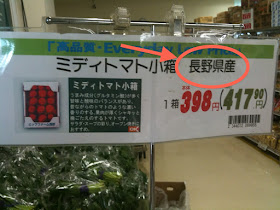Specifically, I want to talk to you about how to detect tainted beef from Fukushima.
But first, a few tips about produce. Many farms use pesticides and insecticides on produce to protect it from bugs and disease. I strongly suggest washing off all fruits and vegetables well before consuming. I also strongly suggest peeling the skin off of any produce whenever possible before consuming. Even if you don't eat the rinds on some fruits (like melons) you should still wash them before cutting as bacteria on the skin could wind up on the knife as you cut into the fruit.
Here are more great tips on washing produce properly.
Now, onto that controversial tainted beef from Fukushima. Pay careful attention as I will now demonstrate to you how to detect this beef product - or any other tainted product - easily and simply when shopping at stores in Japan.
This is not exactly rocket science.
Any reputable dealer in Japan will list where any product is produced clearly on the product label. It is how the free market works in Japan. All stores list origin of products. If they don't, customers don't shop there.
You must, though, be able to at least read some basic kanji.
Here are some examples. Notice circled areas:
If you ever see a product at a grocery store or a restaurant and it doesn't list origin of ingredients (good restaurants will specify where produce or meats and fish are you) and you want to know, ask.
That's it. Just ask. Or read what the information says.
It's pretty simple.
---------
Important! Recently, the huge retailer Costco had beef at astoundingly low prices here in Japan. Fine. But the beef in question, at the store that I am referring to (Kawasaki Costco), did not list origin on the rack. That is strange! When asked where the beef came from the store clerk whispered, "Fukushima."
Caveat Emptor. Let the buyer beware!
Let also the buyer learn to read and write at least second grade level Japanese if they live here.
And that's how to detect Fukushima beef.
Told you it wasn't rocket science.
For more excellent updates on Fukushima, see Marc Sheffner's Accurate Maps blog: http://www.sheffnersweb.net/blogs/accuratemaps/








Re: How to Detect Radioactive Beef in Japan
ReplyDeleteMike,
I’m not sure about how to detect radioactive beef in Japan, but here is a pretty good way to identify radioactive rabbits:
http://www.youtube.com/watch?v=9s9nKzmbndA
I love this movie. It’s so awful it’s wonderful…
Hi Mike,
ReplyDeleteI really enjoy reading your blog every day. Keep up the good work!!!
My two cents to this post... the following URL enables you to trace the beef:
https://www.id.nlbc.go.jp/english/index.html
It gives you complete info on where the cow was born, raised and slaughtered.
Excellent public service blog, Mike!
ReplyDeleteI actually used to check for the prefecture on my grocery label for no other reason than to see where produce came from... of course this was all pre-nuked cukes!
Not that I bought a lot of veggies. Just kidding. Keep it up! And thanks for including Japan - It's A Wonderful Rife in your blog last week.
This comment has been removed by the author.
ReplyDeleteGreat advice. So simple and easy to understand. However, that third picture of beef is from Tochigi Prefecture, not Ibaraki. Not that it really matters, as long as it's not Fukushima, right?
ReplyDeleteMissing a key point here, cows were sent out of Fukushima to other preectures, then they were slaughtered, the beef is thus labelled as being from wherever its slaughtered... Its an old trick over here... Just like horse meat in Kumamoto, they are actually canadian horses originally..
ReplyDeleteSo what to do? get a geiger counter.
My family, while rarely eating beef, do enjoy New Zealand beef (by far the best tasting and healthiest) and Aussie beef (tastes OK... Sometimes really good... Healthy)..
ReplyDeleteWe NEVER eat USA beef or pork products and do not eat Japanese ones either!
I'll find the Kiwi beef distributor in Tokyo and post about it.